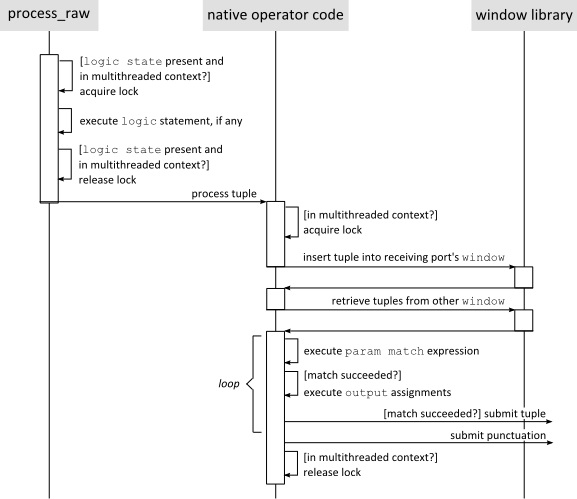Operator invocations
The purpose of SPL is to allow users to create streams of data, which are connected and manipulated by operator invocations.
SPL programs are deployed on distributed hardware for scaling. The main goals of SPL are scalability (using distributed hardware), extensibility (encapsulating low-level code in high-level operators), and usability (easing the writing of scalable and extensible code).
stream<int32 i> Strm1 = SomeOperator(Strm2)list<int32> list1 = someFunction(list2)stream<rstring buyer , rstring seller, rstring item> Sale = Join (Bid ; Ask ) {
window Bid : sliding , time (30);
Ask : sliding , count (50);
param match : Bid.item == Ask.item && Bid.price >= Ask.price;
output Sale : item = Bid . item;
}Each operator invocation has a head and a body. The head (Line 1 in the example) lists the connected streams and the operator that is used to process these streams. The body (Lines 2-6 in the example) elaborates on how the operator is to be invoked. The BNF syntax is:
opInvoke ::= opInvokeHead opInvokeBody
composite SaleJoin {
graph
stream<rstring buyer, rstring item, decimal64 price>
Bid = FileSource() { param file : "bids.txt"; }
stream<rstring seller, rstring item, decimal64 price>
Ask = FileSource() { param file : "asks.txt"; }
stream<rstring buyer, rstring seller, rstring item, uint64 id>
Sale = Join(Bid; Ask)
{
logic state : mutable uint64 n = 0;
onTuple Bid : n++;
window Bid : sliding, time(30);
Ask : sliding, count(50);
param match : Bid.item == Ask.item && Bid.price >= Ask.price;
output Sale : item = Bid.item, id = n;
config wrapper : gdb;
}
}
- The
logicclause consists of local state that persists over the whole program execution, and statements that execute when a tuple arrives on an input port (see Logic clause). - The
windowclause specifies how many previously received tuples of each port to remember for later processing by stateful operators such as Join, Sort, or Aggregate (see Window clause). - The
paramclause contains code snippets, such as expressions, supplied to the operator at invocation time; at run time, the operator executes them whenever needed for its behavior (see Param clause). - The
outputclause assigns values to attributes in output tuples each time the operator submits data to an output stream (see Output clause). - The
configclause gives directives and hints that influence how the compiler builds this operator invocation, or how the runtime system executes it (see Config clause).
Clause order follows the typical execution order. Execution order is operator-specific, and the
figure Figure 1 shows a simplified
execution order for the Join operator, which is typical for other operators as
well. When a tuple arrives, logic executes first, followed by interacting with the
window, executing param expressions, and finally assigning
output attributes when the operator submits a tuple. Since the user rarely needs to
see configuration options to understand what the code does, they have their own clause at the end of
the operator invocation body. The operator invocation body syntax is:
opInvokeBody ::= ‘{'
( ‘logic' opInvokeLogic+ )?
( ‘window' opInvokeWindow+ )?
( ‘param' opInvokeActual+ )?
( ‘output' opInvokeOutput+ )?
( ‘config' configuration+ )?
‘}'
opInvokeLogic ::= opInvokeCode | opInvokeState
opInvokeCode ::= 'onProcess' ':' stmt
| ( 'onTuple' | 'onPunct' ) ':' stmt # ID is input port
opInvokeState ::= 'state' ':' ( varDef | '{' varDef+ '}' )
opInvokeWindow ::= ID ':' expr+, ';' # ID is input port
opInvokeActual ::= ID ':' opActual ';' # ID is param name
opInvokeOutput ::= ID ':' ( ID '=' expr )+, ';' # ID is output port
configuration ::= ID ':' expr+, ';' # ID is config nameThe
syntax of an operator invocation body vaguely resembles that of a
switch statement in Java™, or
a class with public/private sections in C++. The compiler, in addition
to the syntactic constraints shown here, enforces semantic constraints
on each clause. For example, only the windows that are described in
the Window clause are
legal in the window clause.
